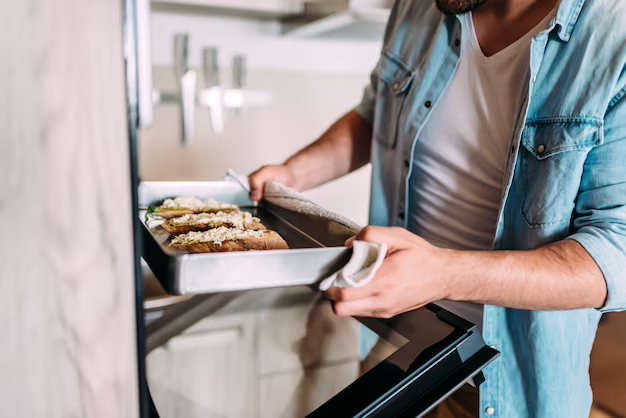Can You Put Warm Food in the Refrigerator? Here’s What You Need to Know
Have you ever cooked a delicious dinner, only to wonder if you should let those leftovers cool down or pop them straight into the fridge? This question plagues kitchens across the globe, where efficiency meets safety. Let’s explore this dilemma, discuss its implications, and unpack the ideal practices for handling warm food.
🌡️ Understanding the Science of Temperature
Refrigeration is a cornerstone of food preservation, utilizing cold temperatures to slow down bacterial growth and keep food safe for longer durations. However, the introduction of warm or hot food into a refrigerator can alter this delicate balance.
The Danger Zone
The “danger zone” refers to temperatures between 40°F and 140°F. It’s within this range that bacteria such as Salmonella and E. coli can thrive. Understanding how food temperature affects bacterial growth is crucial in kitchen safety.
Impact on Refrigerator Function
Introducing hot food into a cold environment causes an imbalance, forcing the refrigerator to work overtime to cool the interior back down and keep other stored items safe. This can potentially affect your refrigerator’s efficiency and longevity.
Is It Safe to Refrigerate Warm Food?
The answer isn't entirely straightforward. While modern refrigerators are designed to handle periodic spikes in temperature, overloading them with hot items frequently can diminish cooling efficiency, affecting energy consumption and food safety.
Factors to Consider:
- Food Quantity: A single plate of warm food is unlikely to disrupt refrigerator temperatures significantly, but a large pot of soup might.
- Type of Food: Dense foods retain heat longer than liquids or less solid foods and may need additional cooling time before refrigeration.
- Refrigerator Size and Model: Some models are more efficient at maintaining a stable temperature than others.
Best Practices for Refrigerating Warm Food
When faced with the decision of whether or not to refrigerate warm items, several best practices ensure both food safety and refrigerator efficiency.
🕑 Allow Cooling Time
Allowing food to sit out for a short period can reduce its temperature naturally, but ensure it doesn’t remain in the danger zone for longer than two hours to prevent bacterial growth.
🍲 Use Shallow Containers
Transfer food to shallow containers to increase the surface area exposed to cooler air, facilitating faster cooling—both outside and inside the refrigerator.
❄️ Dividing Large Batches
Splitting large amounts of food into smaller batches promotes quicker cooling and reduces the demand on your refrigerator when stored.
Contextual Factors: Climate and Environment
The environment surrounding where you live can affect how you manage warm food storage. Warmer climates may accelerate bacteria growth, necessitating more immediate refrigeration or cooling methods.
Additional Considerations: Food Quality and Texture
Beyond safety, how you store food can affect its taste and texture. Rapid cooling can sometimes lead to condensation, resulting in soggy food textures or ice crystals forming on non-airtight foods.
Let's Summarize! Key Tips for Refrigerating Warm Food
- 🕑 Allow Food to Cool: Let food sit for about an hour before refrigeration unless it's a minimal portion.
- 🔄 Transfer to Shallow Containers: This ensures faster cooling.
- 🍲 Divide and Conquer: Split large quantities into smaller ones for quicker cooling.
- ❄️ Be Mindful of Placement: Store items strategically, allowing for ample airflow around them.
- 💡 Be Aware of Your Environment: Adapt techniques to your local climate.
Addressing Common Myths
Misconceptions abound regarding warm food storage. Let’s tackle a few:
Myth 1: Hot Food Ruins Your Fridge
While it’s true a significant temperature spike can affect fridge efficiency, occasional hot foods won’t ruin your appliance. Consistent overloading, however, is discouraged.
Myth 2: It Must Cool Completely
Food doesn’t need to be completely cool before entering the refrigerator; it just needs to be out of the danger zone.
Myth 3: Leaving Food Out Prevents Contamination
Contrarily, leaving food out can risk exposing it to contaminants in the environment, especially if left unattended for too long.
Practical Steps and Cautions: Preparing Food for the Refrigerator
When preparing to place warm food in the refrigerator, follow these practical steps:
- Assess Food Type: High-moisture foods like soups should be transferred to a shallow container with a lid.
- Consider Time Limitations: Avoid leaving food unrefrigerated for more than two hours.
- Practice Safe Placement: Ensure that foods are not stacking tightly but placed to allow air circulation.
- Monitor Temperature Changes: Particularly if adding many warm items, check if the fridge regains optimal temperature swiftly.
Healthy Kitchen Habits: Regular Monitoring and Cleaning
Maintaining a healthy kitchen not only involves understanding food safety but also includes routine refrigerator maintenance.
- 🔍 Regularly Check Temperature Settings: Ensure it remains below 40°F.
- 🧹 Clean Spills Promptly: To prevent odors and contamination.
- 📦 Rotate Stock: Use older food first to minimize waste and spoilage.
Closing Insight
In exploring whether it’s okay to put warm food in the refrigerator, the answer lies in balance. Consider the factors influencing your specific scenario: food type, quantity, and environmental conditions. Implement best practices to comply with safety standards and preserve the taste and quality of your meals. By managing these variables, you ensure efficient and safe food storage, supporting both optimal refrigerator performance and food safety.
